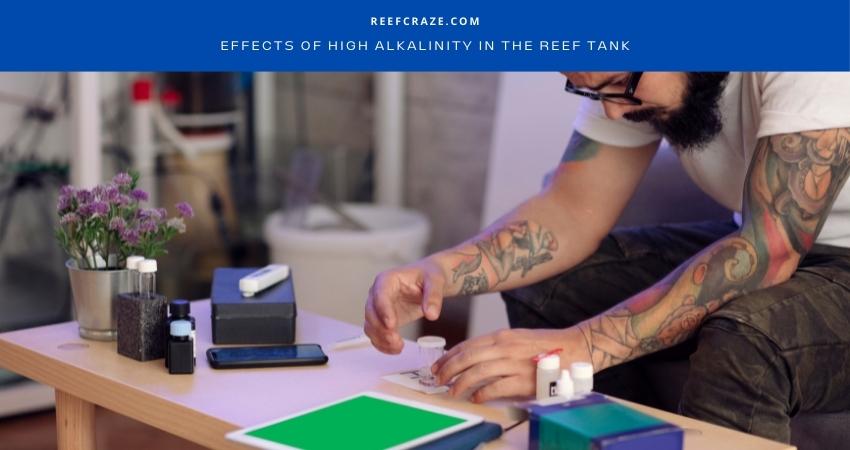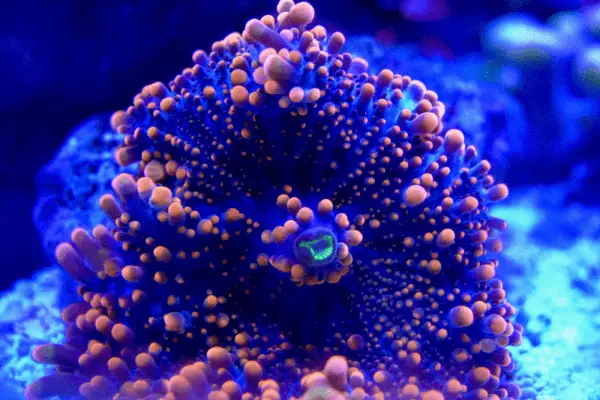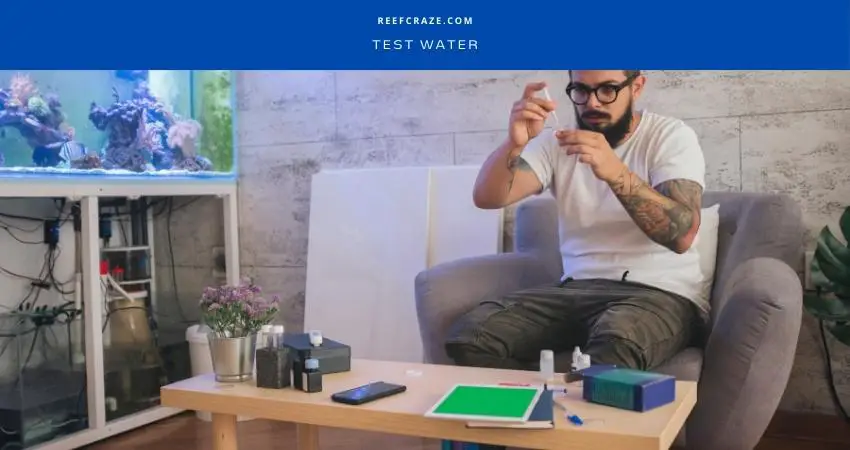When the alkalinity level goes higher than required in the reef tank, the fishes and the tank equipment may get damaged. It is important to lower alkalinity in the reef tank gradually so that the adverse effects do not affect the tank inhabitants badly. In this article, I will explore the steps you should follow to lower the alkalinity level in the reef tank.
You can lower the alkalinity level in the reef tank by changing a portion of water daily, adding organic acid like vinegar in the tank, and waiting for the corals to uptake the alkalinity. Make sure that you do not lower the alkalinity level too much and the pH and calcium levels are stable.
So, are you interested in diving deep inside all the methods of lowering the alkalinity level in your reef tank? Then this is the post you should not skip. Keep reading, and you’ll get to know how you can lower alkalinity in the reef tank.
Alkalinity Basics
Before discussing the methods of lowering the alkalinity, let’s first explain what alkalinity is.
Alkalinity measures the effectiveness of the water in neutralizing the acids. dKH or calcium harness is the unit to measure the alkalinity. Mathematically, 17.9 ppm or 17.9 mg/L calcium carbonate makes 1 dKH of alkalinity.
You can trace the amount of carbonate and bicarbonate in the reef tank water if you determine the level of alkalinity. Alkalinity will also give you an idea about whether the pH level in the water is stable or not.
Generally, if the alkalinity does not drop significantly or drastically, the pH level remains stable. A proper level of alkalinity is essential for reef tanks because the survival of the corals in the reef tank depends on bicarbonate. Alkalinity also contributes to the strength of the skeleton.
If you have a reef tank, you should keep a careful look at the level of alkalinity as too low and too much of it can hinder the growth of the inhabitants in the aquarium. The first step to ensuring the right level of alkalinity in the water is to test the water. You should test the water of the reef tank at least once a week to find the level of alkalinity so that you can correct the level as required.
Effects of High Alkalinity in the Reef Tank
Keeping the aquatic animals in their native environment is the best way to keep them healthy and growing. If you are an aquarist, you should make sure that the fishes in the tank are accompanied by corals, plants, some places to play hide and seek, and some other fishes to swim and chase.
You are also supposed to give them clean water with the right balance of chemicals. If the alkalinity is too low or too high, the creatures in the reef tank might undergo severe health problems.

The alkalinity level in the seawater generally ranges from 8 dKH to 12 dKH which can be translated into 142 ppm to 215 ppm. This can also be taken as the perfect alkalinity level in the reef tank. Once the alkalinity level goes beyond 12 dKH, that can cause damage to the fishes, corals, and the tank equipment like pumps and heaters. Let’s have a look at the negative effects of high alkalinity:
Adverse Effects on Fishes
The fishes in the reef tank suffer from many health issues if there is too high alkalinity in the water.
High alkalinity for a prolonged period damages the mucus layer that protects the fishes from bacteria and infection attack.
Once the alkalinity level goes beyond the expected range, the fish become prone to be affected by infection and bacterial as an outcome.
Even the non-toxic ammonia can turn toxic when the water is too much alkaline. High alkalinity is also responsible for causing breathing problems in the fishes.
The fins and tails of the fish are not out of the risk. The growth of the fish declines, and ultimately they look ragged. Some fishes are more fragile to alkaline issues and can eventually die.
Negative Impact on Calcium
The inhabitants of the reef tank can tolerate a good amount of alkalinity. Some aquarists even use doses of bicarbonate or baking soda to raise the level of alkalinity to make sure the faster growth of corals.
One of the main problems with a high level of alkalinity is that it interferes with the calcium uptake by the animals in the aquarium. If the alkalinity is too high, there is a possibility that solids like calcium will precipitate beyond the water base and thus become unavailable for the inhabitants of the tank. This ultimately will hamper the growth of the tank residents.
Additional Read:
Tank Problems
Excessive alkalinity does not only affect the fishes, corals, pH, and calcium, it is also responsible for causing some problems in the tank system. Higher alkalinity precipitates the calcium out of the water which in turn can coat the inner part of the tank, the pump, the filters, and the heater.
Besides blocking your view into the tank, it can also damage the equipment, obstruct the proper flow of filters, and burn out the pumps. When the alkalinity level is within the recommended range, the equipment of the aquarium remains safe from any damage.

How to Lower Alkalinity in Reef Tank: 6 Steps to Follow
By now you know how high level of alkalinity kills both the corals and fishes along with destroying the equipment of the reef tank. Let’s now see the steps you should follow to lower the alkalinity in the reef tank.
Step 1: Test the Water in the Reef Tank
To decide the level of alkalinity you need to lower, the first thing you should do is to test the water in the reef tank, you have to make sure that you tested the alkalinity, pH, and calcium in the water.

You can either check these with either test kits or test strips. Though test kits are more accurate, using test strips also works fine. Just make sure that you can judge the degree of alkalinity by comparing the color found by the test with the color standard mentioned by the manufacturers of the kits or strips.
Also, note that you should follow the process of testing the water for alkalinity, pH, and calcium recommended by the manufacturers of the kits or strips you have bought.
When it comes to alkalinity level, it should be within 8-12 dKH. You can find the level of alkalinity by following any of the two standards:
- Alkalinity (dKH) = (Volume of acid used/ Water sample volume) *280
- Alkalinity (meq/L) = (Volume of acid used/ Water sample volume) *100
If you do it for the first time, you can check the alkalinity level with two test kits from two brands. Though it might seem costly, and you need to put more effort, it is good to try this way. It helps especially when one test kit malfunctions, or you make a mistake in any test process.
Step 2: Change the Tank Water Regularly
One of the ways to correct the alkaline in the water is to change 20% to 25% of the existing water daily as long as you do not reach the desired alkalinity level (which is usually 8-12 dKH for reef tanks). Though this might not seem to be the most exciting way to reduce alkalinity in the reef tank, it works. Regular changes in water have other benefits as well.
If you want to improve the quality of water, you can also add some salt to the reef tank water. Just make sure that the salt mix you are adding comes with 8 dKH or below, not more. It is better to replace about 20% of old water with fresh water containing the salt mix. This will ensure better efficiency.
Step 3: Add Organic Acid Like White Vinegar
Adding a small dose of white vinegar can be the game-changer for lowering the alkalinity in the reef tank. It will help to reduce the alkalinity level almost at once. But, as it also lowers the pH level, you should not use any organic acid like vinegar often.
If the pH level drops significantly due to the use of organic acid, here’s what you should do to restore the pH:
- Stir the surface of the tank water. When you agitate the water, the gas exchange will improve in the water. As a result, the oxygenation of the reef tank will increase the pH level will be back to normal again.
- Move the powerheads and return pump outlets towards the water surface.
Step 4: Wait for a Few Days
Do not get tensed or make a hurry to lower the alkalinity level if you observe a sudden rise in the alkalinity in your reef tank. A sudden rise in alkalinity might take place and that can also drop by the passage of time. The corals in the reef tank can uptake the alkalinity gradually.
Note that, if the alkalinity level has not gone too high, you should take some time to monitor and let the alkalinity come to normal. The time required for the corals to uptake the alkalinity might differ from tank to tank and depend on the size and number of the corals you have in your reef tank.
You can usually expect about 1-2 dKH drop in the alkalinity level with the help of the corals. A big advantage of waiting for the corals to lower the alkalinity is that the pH level in your tank does not get affected negatively.
Step 5: Bringing a Balance Between Alkalinity and Calcium
Alkalinity and calcium are interrelated. There are certain issues in calcium that can affect the alkalinity. It is important to make a balance between alkalinity and calcium to bring the first at the normal level. Let’s explore the ways to correct the imbalances between alkalinity and calcium in different situations:
- Keep using the calcium and alkalinity properly and equally if both the calcium and alkalinity are unusually high. It is about time that will solve everything gradually and bring equilibrium back.
- Once you see that both the calcium and alkalinity are unusually low, you should add those supplements in equal portions to the reef tank to correct the issue. But, if the issue persists, test the magnesium level in the fish tank. If the magnesium level is below 1200 ppm you need to add more magnesium.
- If it is found that the calcium is too high compared to the alkalinity, you might need to use any alkalinity supplements to increase it. But, keep yourself refraining from using any additives based on calcium. Kalkwasser or lime water is also a no-no as it might increase the calcium more. However, if the high calcium issue persists, you should check if the magnesium level has dropped. In case it drops below 1200 ppm, you need to add more of it to the aquarium.
Step 6: Maintain Water Quality
Maintaining the overall quality of the water will help to keep the alkalinity in balance. Let’s see some of the ways that will help you maintain the quality of the tank water.
- Reducing the water hardness will regulate the higher sodium, calcium, magnesium and other minerals dissolved in the tank. Too hard water has adverse effects on certain types of fish. You can make use of RO water to lower the water hardness. But, I suggest you not to use tap water softener as that uses sodium to replace the magnesium and calcium. Excessive sodium is not useful for the creatures of the reef tank in any way.
- Keep checking the temperature of the water and alkalinity levels. If you have just installed a reef tank, you should check the pH and alkalinity levels more frequently. Keep a thermometer to keep track of the tank temperature regularly. Make sure that the aquarium heater is not broken and works fine without malfunctioning. If you find that the heater is not working properly, get it fixed by a professional or buy a new one as soon as possible.
- Testing the nitrogen cycle with the help of the ammonia kit can change the chemistry in the water a lot. As a high ammonia level can harm the fish, you should make sure that you get that tested now and then.
- Apart from changing 20% to 25% of tank water after a certain interval, you should also take care of your tank. Keep the rock clean. You can use dilute vinegar liquid or freshwater to clean the tank wall, gavel, and other decoration items.
Things to Remember while Lowering the Alkalinity Level in Fish Tank
- Double-check the alkalinity before you take steps to reduce the alkalinity in the aquarium. It is because if you guess the alkalinity level wrongly and start to work for lowering the alkalinity, you might end up making a total mess with the fish, coral, and the water especially if it is a nano reef tank.
- Use two test kits from two different manufacturers to be sure that your alkalinity test is accurate. Do not let the malfunctioning of the kit or your inexperience ruin your reef tank.
- When you apply any organic acid like white vinegar in the reef tank water, make sure that the dose is initially small.
- Using a pH buffer in the reef tank can skyrocket the alkalinity level. So, try other ways to keep the pH level stable if you are trying to lower the alkalinity level.
- Conduct a magnesium test if there are issues with calcium and alkalinity.
Final Thoughts
Lowering the alkalinity takes time and effort. You cannot do it overnight. Even if you try to do so, you will not get any impressive results. Rather, you might end up harming the fishes and corals by creating imbalances in other elements of the tank.
We hope that this step-by-step guide on how to lower alkalinity in the reef tank will help you to control the alkalinity without harming the creatures of the tank.


Very useful article. Thank you. I have a peculiar case of Alk nearing 11 after being at 8 and me adding a baking soda mix. Calcium is off the scale despite several water changes and I think its my Reef Crystals salt which I should have been less generous with when mixing with my RO water. I think I need to be patient as I have a heavy bioload and only 2 softie corals in a 100 gallon tank.